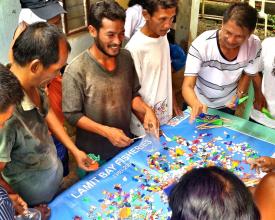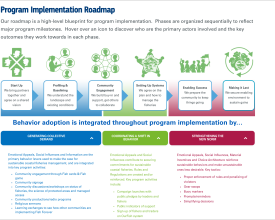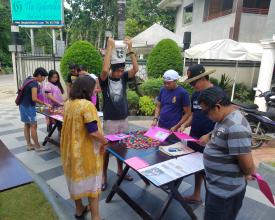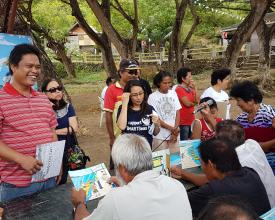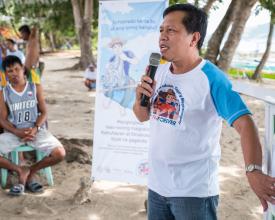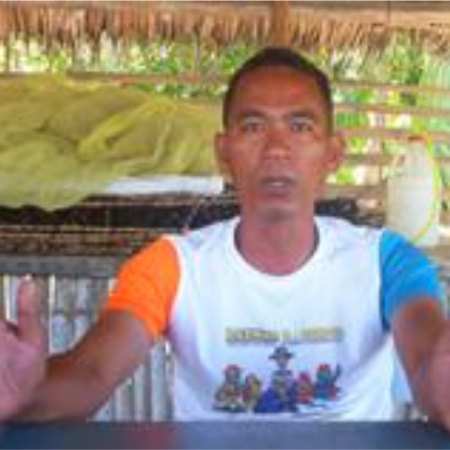
Community Engagement and Behavior Adoption in the Fish Forever program
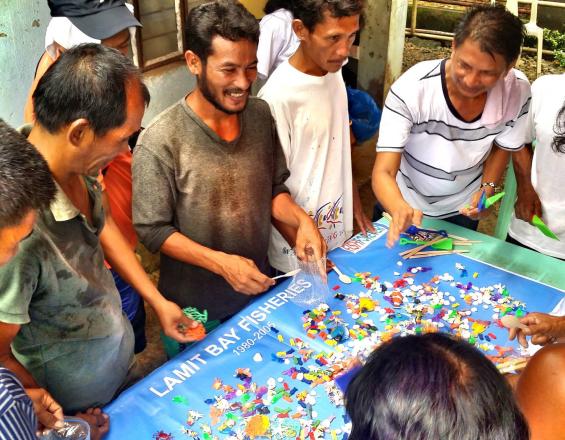
For MPAs to succeed, the science, governance and enforcement need to be supported by community buy-in and compliance. In Rare's Fish Forever program, networks of marine reserves and managed access are established and strengthened using proven community engagement and behavior adoption approaches at each stage of the process. This helps ensure that fishers and local stakeholders 'own' the solution and are inspired to sustain protection and conservation efforts for the long term.
Context
Challenges addressed
Successful management of MPAs depends on being able to address the perceived conflict between protecting and conserving marine resources and the needs of communities for food and livelihood
Beneficiaries
Local governments and community-based organizations, fishery leaders, and ultimately, fishers and their communities.
Location
Process
Summary of the process
In the Fish Forever program, local governments enter into a partnership with Rare to work towards sustainable coastal fisheries. The local government assigns a campaign implementation team that receives a series of trainings, coaching and mentoring on how to apply community engagement and behavior adoption strategies towards the establishment and strengthening of protected and managed access areas. They are provided with various tools and resources, which they adapt to the local context and roll out over the course of 2-4 years.
Building Blocks
Training on Community Engagement and Behavior Change
A series of workshops train teams from local government units and other supporting organizations on how to utilize behavioral insights to inspire action. They learn how to use qualitative and quantitative research to generate insights, participatory approaches to get people towards shared goals, and tactics that help move the group through different phases of change, from building collective demand, to coordinating the shift, then strengthening norms. They practice designing and implementing their own activities, develop materials and assess their progress.
Enabling factors
Willingness of the local government unit • Availability of funding for materials and activities • Well-coordinated local government unit • Efficient and motivated staff
Lesson learned
The training needs to be practical and within the conceptual reach of the intended beneficiaries, implementers, communities and local governments units. Academic concepts need to be communicated in a simple and understandable manner to be appreciated. Practical examples and bright spots are important. Guidance on next steps helps ensure long-term sustainability of efforts. Encouraging creativity and inventiveness will allow the communities to accomplish the objectives with minimal cost and effort. Cross-visits and inter-community sharing of experiences have greater impact than lectures.
Tools and Resources
During their training, campaign teams are exposed to a wide range of tools and resources that they can use to develop and implement their Community Engagement and Behavior Adoption campaigns. These include a simplified framework for behavior change which covers the strategic levers and tactics that can be applied, tools to spark discussions on MPAs and fisheries, such as a Fishing Game and picture cards, worksheets for campaign planning, and templates for social marketing collaterals that can just be adapted for local use.
Enabling factors
Materials are developed following a user-centered design process so they are easy-to-use • Tools are prototyped, tested and updated regularly • Users are given leeway to adapt most of the tools to accommodate local context
Lesson learned
The goal is to provide campaign teams with enough resources and inspiration so that they can run campaigns themselves. The tools themselves do not need to be perfect, as they will always be used in different ways. As long as the basic concepts and outcomes of an activity are clear, teams can take the guidance and make it their own.
Local Site Implementing Teams
The community engagement and behavior adoption campaigns were co-developed and implemented by teams based in the communities. They were usually composed of staff from the local government unit and local community leaders, like fisher leaders or organizers. They were the ones that received the training and provided with the tools and resources. They adapted the strategies to suit their own context, came up with execution ideas, and rolled out the activities.
Enabling factors
Official designation by the local chief executive (mayor) • Representation from stakeholders other than the local government • Credibility and standing in the community
Lesson learned
Best to have a team of at least three, so that the work does not become overwhelming, and so diverse talents and interests are available to the team. The ideal mix has someone who is well-embedded in government, who can secure approvals and budgets, someone who is creative and able to use basic tools for design, and someone who is well-accepted by the community who knows how to engage and facilitate. They should all know how to mobilize volunteers, and have some basic skills in project management.
Impacts
Across 20 sites in the Philippines, there were significant improvements in social metrics like increased participation, trust and cohesion, positive shifts in knowledge and attitudes, and decreased violations. In-water surveys in these sites also showed increases in fish abundance and biomass inside and outside of the no-take zones, especially at sites that had sustained their community engagement campaigns for more than 4 years.
Sustainable Development Goals
Story

For decades, dynamite fishing in Bindoy was widespread and intergenerational, even routine. Edgar Torres, a fisherman relates, “I was not scared of dynamite fishing because we caught a lot of fish. Sacks of fish.”
By 1998, Mayor Valente Yap knew he had to do something. The reef had been pummeled by illegal fishing for years, and he was concerned about the impact on local food and job security. For the next two decades, this was his mission.
First, he worked to convince local fishers to accept the declaration of a marine protected area (MPA). Fishers initially protested the idea for fear of the near-term impact of closing off access to the teeming Mantalip reef. Then he strengthened the local enforcement team to target illegal fishers using methods like dynamite and cyanide.
Mayor Yap and the municipal government also set out to change attitudes toward illegal fishing, not by shaming illegal behavior, but by bringing about a community-wide conservation ethic. In 2012, Bindoy partnered with Rare to carry out a Rare Pride campaign for sustainable fishing, aiming to inspire the community to pivot their focus from short-term gains to the long-term benefits of sustainable behaviors.
Municipal government staffer Richard Balauro led Bindoy’s Pride campaign. Richard and his team hosted participatory events and workshops with people’s organizations, put up billboards, and sparked conversations. They hosted events like Fisherfolks’ Day and Libod Sayaw Festival, where locals met Bindoy’s Pride mascot, Lovie, a black-spotted snapper, the species found on Mantalip Reef.
Mayor Yap says the community engagement was essential for Bindoy’s transformation. “We cannot implement enforcement and all these programs for the environment without the support of people’s organizations,” he says. “Rare’s social marketing was able to help us change the thinking of our fishers and people from coastal barangays, and [show them] that what we are doing is for their welfare.”
The campaign helped fishers like Edgar Torres understand how their relationship with the marine environment needed to change. “When there was a move to declare Mantalip as a protected area, I was opposed to the proposal,” he says. “I was thinking, as a fisher, where would we fish? The Pride campaign convinced me to change my mind. I focused on the future of my family. That became my goal, to fish responsibly so my children would have a better tomorrow.”
